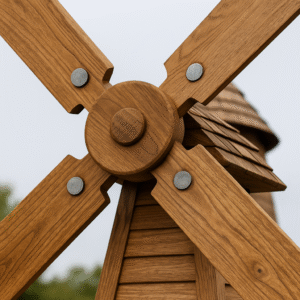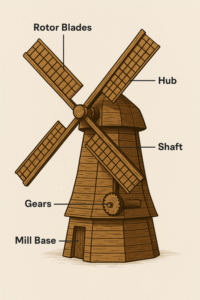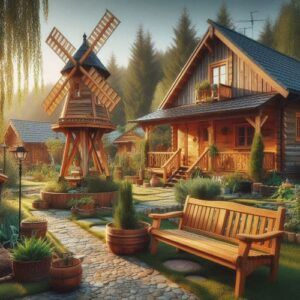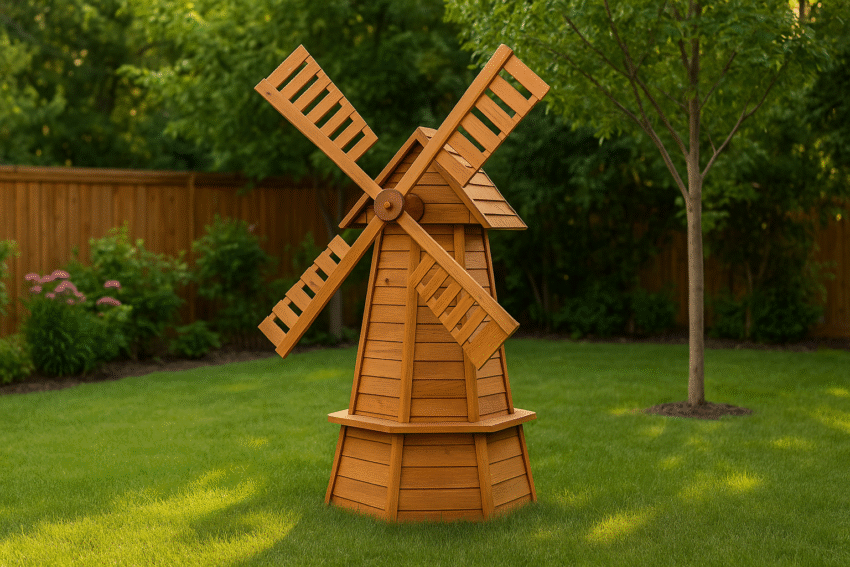A Brief History of Windmills
Windmills have played a pivotal role in human progress for centuries. Long before they became charming features in gardens, they were essential machines that harnessed the power of the wind to make daily life easier. From grinding grain and pumping water to generating electricity, windmills symbolize human ingenuity and our ability to work with nature instead of against it.
Originally, windmills were built to grind grain into flour, transforming farming communities by saving countless hours of manual labor. In agricultural societies, they became symbols of innovation, helping families and villages thrive by turning natural wind power into practical work.
As time went on, windmills found new applications. They were widely used for pumping water, both for irrigation in farming and for draining low-lying land. Nowhere is this more iconic than in the Netherlands, where wooden windmills became essential for managing water and shaping the country’s landscape.
The Industrial Age pushed windmill design even further. With the advent of electricity, wind power shifted from grinding grain to generating energy. This evolution marked the beginning of what we now know as modern wind turbines—sleek, powerful machines that continue to supply sustainable energy around the world.
Through all these changes, the design and materials of windmills also evolved. Early versions were often built from locally sourced wood, chosen for its sturdiness and availability. These wooden structures dotted countrysides for centuries, standing as both practical tools and symbols of resilience.
By understanding their history, we can see that windmills are much more than decorative structures. They tell a story of adaptation and resourcefulness, showing how simple wooden constructions helped lay the groundwork for sustainable technologies we still rely on today.

Recommended Tools and Materials
If you’re inspired to build your own windmill, here are a few resources to get you started:
-
Cedar Boards for Outdoor Projects – weather-resistant and perfect for garden windmills.
-
DIY Wooden Windmill Kit – includes pre-cut pieces and instructions for beginners.
-
Woodworking Plan Collection – hundreds of step-by-step guides, including outdoor projects like windmills.
As an Amazon Associate, I earn from qualifying purchases. These links help support this site at no extra cost to you.
Step-by-Step Guide: Building Your Wooden Windmill
Now that you know the background and have resources ready, let’s dive into the actual build.
1. Choose the Right Wood (Cedar or Oak for Durability)
The foundation of any windmill starts with the wood you select. Hardwoods such as oak or cedar are excellent choices because they resist weathering and provide long-lasting strength. Cedar, in particular, holds up well outdoors, making it a favorite for yard and garden projects.
2. Use Detailed Plans or PDFs for Accuracy
Once you’ve picked your materials, work from a set of clear plans. A step-by-step woodworking PDF or sketch with measurements ensures that you can visualize the build before cutting any lumber. These plans guide each stage, from constructing the base to attaching the tower and blades.
3. Anchor the Base for Stability
A sturdy foundation is critical if your windmill will be functional. Without proper anchoring, strong winds can topple even the best-built design. Options include setting posts deep into the ground or fastening brackets into concrete footings for extra stability.
4. Position Your Windmill for Best Performance
Where you place the windmill effects both efficiency and aesthetics. Choose a location that gets steady wind exposure but is still easy to access for adjustments or maintenance. Avoid placing it near tall trees, fences, or buildings that can block airflow.
5. Enjoy the Build and the Results
Whether you’re an experienced woodworker or just starting out, building a wooden windmill is a project that challenges your skills while rewarding you with a unique, handcrafted structure. The finished piece adds charm and personality to your outdoor space, while also giving you a deeper appreciation for sustainable, functional design.
Understanding the Anatomy of a Windmill
To appreciate how windmills work, it helps to break them down into their main components. Each part serves a specific purpose, and together they transform the power of the wind into useful motion.
Rotor Blades and the Hub
The blades — the most eye-catching part of any windmill — are designed to capture the wind. As the wind pushes against them, they rotate and transfer that energy to the hub, which holds the blades together. This combination forms the rotor, the key to turning wind’s kinetic energy into mechanical movement.

Traditional Wooden Windmills
In older designs, blades (often called sails) were crafted from strong wood and sometimes covered in cloth to catch the breeze more effectively. These sails were typically mounted vertically and connected to shafts inside the mill. As they spun, they drove gear systems that powered essential tasks such as grinding grain or pumping water.
Modern Wind Turbines
Today’s wind turbines look very different. Instead of bulky wooden sails, they use sleek, aerodynamic blades built from advanced materials. These designs are optimized for efficiency and durability, allowing them to capture more energy while withstanding years of weather exposure.
The Shared Principle
Whether rustic or modern, decorative or industrial, all windmills rely on the same principle: harnessing natural wind and converting it into productive energy. Understanding each part of the system helps us appreciate not only their clever design but also their role in human innovation.

Wooden Windmills for Home and Decoration
Wooden windmills aren’t just about utility — they bring charm and character to gardens and outdoor spaces. Decorative models capture the spirit of traditional mills without the full-scale size or function, making them perfect as yard accents.
If you’re looking to enhance your yard quickly, there are plenty of pre-made wooden windmills available. From rustic styles that echo old-world charm to modern adaptations, you can find options at local garden centers or through online marketplaces.
For woodworkers, building your own windmill is more than just a budget-friendly choice — it’s a chance to add personal craftsmanship and style. Tailor the design to reflect your personality, whether that means keeping it simple and rustic or adding decorative touches that match your landscaping.
If starting from scratch feels overwhelming, DIY kits provide the best of both worlds. These come with pre-cut pieces and step-by-step instructions, letting you enjoy the satisfaction of building without the complexity of full design work.
Adding a wooden windmill to your yard does more than decorate — it creates a focal point, a conversation starter, and a reminder of the ingenuity that windmills have represented for centuries.

Essential Resources & Community Insights
Building a wooden windmill becomes much easier (and more enjoyable) when you tap into the right resources and communities. Instead of approaching the project alone, you can learn from others, find proven plans, and avoid common mistakes along the way.
Online Plans and Tutorials
The internet is full of detailed woodworking guides, many tailored to different skill levels. With a quick search, you can find step-by-step PDFs and video tutorials that cover everything from cutting the base to assembling the tower and blades. For more inspiration, check out Simple Wood Projects for Beginners — a great place to sharpen your woodworking skills before tackling a larger build.
If you prefer a ready-made option, resources like Ted’s Woodworking Plans Collection provide thousands of projects, including decorative windmills and outdoor furniture.
Books and Manuals
Local libraries and bookstores often stock DIY woodworking manuals filled with timeless projects. These guides are especially useful if you prefer working from physical instructions instead of digital screens. Titles focused on outdoor woodworking projects often include sections on decorative windmills. A popular choice is The Complete Book of Woodworking, which provides in-depth projects and techniques for beginners and advanced builders alike.
Forums and Local Clubs
Joining a community of woodworking or windmill enthusiasts is one of the best ways to learn. Online forums, social media groups, or local woodworking clubs provide shared knowledge, troubleshooting advice, and even encouragement when you hit a snag. Sometimes, a tip from someone who’s already built their own windmill can save hours of trial and error.
Legal and Zoning Considerations
Before building, take time to review local zoning regulations. Some areas restrict structure height or placement, even for decorative windmills. A quick call to your local planning office or homeowners’ association can prevent headaches later.
Building More Than a Windmill
These resources and connections don’t just help with your current project — they open the door to a broader woodworking journey. Whether you’re browsing online plans, flipping through a library manual, or chatting with other DIYers, you’re not just constructing a windmill. You’re becoming part of a community that values craftsmanship, creativity, and sustainable design.
For a smaller but highly practical addition to your toolkit, consider a Sharpening Stone Kit — keeping your chisels and blades sharp makes every woodworking project smoother and safer.
Global Significance and the Role of Windmills Today
Windmills have left an undeniable mark on cultures and landscapes around the world. The Netherlands is perhaps the most iconic example, where windmills were once essential for land reclamation and now stand as national treasures. These structures remind us of a time when communities relied on ingenuity and craftsmanship to harness natural resources.
In the modern era, windmills have evolved into wind turbines that play a vital role in renewable energy. They contribute to reducing carbon emissions and advancing sustainable electricity generation. While their scale and materials are far removed from traditional wooden mills, the principle is the same: capturing wind and turning it into power.
Of course, wind energy comes with challenges. Large turbines can impact local ecosystems and sometimes face opposition due to noise or their visual footprint. Yet they remain one of the most promising tools in the fight against climate change. For a deeper dive into sustainable woodworking and eco-friendly design, check out The Art of Inlay — another way to blend tradition with modern creativity.
In educational settings, windmills continue to serve as powerful teaching tools. From demonstrating basic engineering principles to sparking discussions about renewable energy, they inspire new generations to think sustainably. If you’d like to explore the technical side further, resources like Wind Energy for the Rest of Us offer a practical look at how wind power works today.
And whether you’re inspired by the rustic charm of an old mill or the sleek efficiency of a modern turbine, remember that woodworking gives you the chance to bring that legacy home. Even a small decorative windmill can serve as a reminder of humanity’s long partnership with the wind. If you’re building your own, having reliable measuring tools is a must — something like a Digital Angle Finder and Protractor makes accurate cuts and assembly far easier.
Final Thoughts
Building a wooden windmill is more than just a DIY project — it’s a way to connect with history, sharpen your woodworking skills, and add a unique touch to your outdoor space. From the traditional mills that once powered communities to the decorative versions that brighten today’s gardens, windmills represent both ingenuity and craftsmanship.
If you’re ready to take on more woodworking challenges, start with projects that build confidence and skill. Simple Wood Projects for Beginners offers step-by-step ideas to help you grow as a maker. Once you’re comfortable with tools, check out Top 5 Essential Tools Every Woodworker Needs to make sure your workshop is stocked with the right gear. And for those who want to add artistic detail to their builds, Wood Inlay: Adding Detail to Your Projects is a great next step in expanding your craftsmanship.
Whether you purchase a kit, follow detailed plans, or design your own, your wooden windmill will stand as both a decorative feature and a tribute to timeless design. Enjoy the process, take pride in the result, and keep exploring new projects that challenge and inspire you.
Happy building!
Here’s Another Great Source for Woodworking Plans and Tutorials
If you’d like to explore more woodworking ideas beyond windmills, I recommend checking out Ted’s Woodworking. It’s one of the largest collections of woodworking plans available online, with 16,000+ projects ranging from simple beginner builds to advanced designs.
Whether you’re interested in outdoor decor, furniture, or detailed workshop projects, Ted’s plans give you step-by-step instructions and diagrams that make building easier. It’s an excellent resource if you enjoy having a variety of designs at your fingertips.
Interested in Building a Business in Crafting?
If woodworking is more than just a hobby for you, why not turn that passion into income? There are hundreds of ways to build a business around crafts, from selling handmade projects to teaching your skills online.
Wealthy Affiliate offers tools, training, and community support to help you create a business around what you love. Whether you’re a beginner or experienced, it’s a great place to explore how to grow your craft into something bigger.




